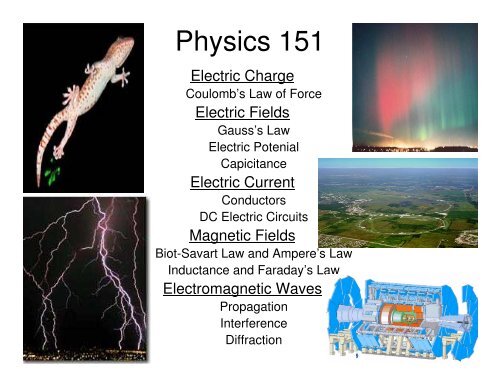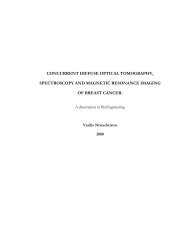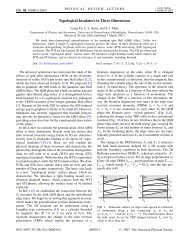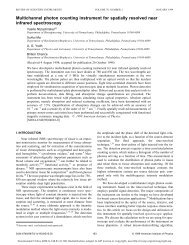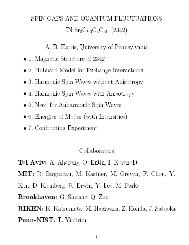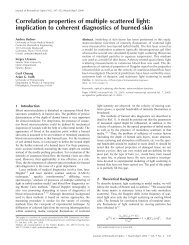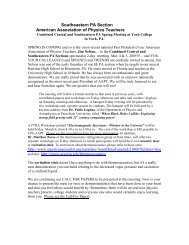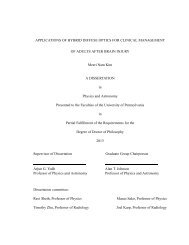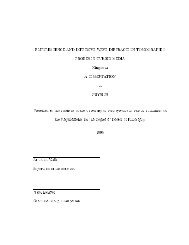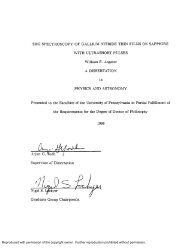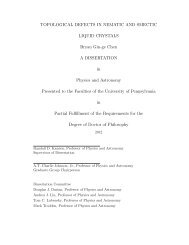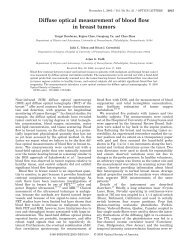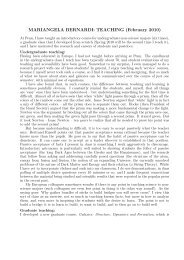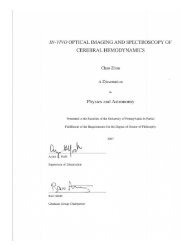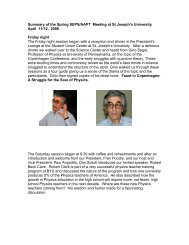Physics 151
Physics 151
Physics 151
You also want an ePaper? Increase the reach of your titles
YUMPU automatically turns print PDFs into web optimized ePapers that Google loves.
<strong>Physics</strong> <strong>151</strong><br />
Electric Charge<br />
Coulomb’s Law of Force<br />
Electric Fields<br />
Gauss’s Law<br />
Electric Potenial<br />
Capicitance<br />
Electric Current<br />
Conductors<br />
DC Electric Circuits<br />
Magnetic Fields<br />
Biot-Savart Law and Ampere’s Law<br />
Inductance and Faraday’s Law<br />
Electromagnetic Waves<br />
Propagation<br />
Interference<br />
Diffraction
Electric Charge<br />
• Experimental findings<br />
– Exists in two forms: called positive (+) and negative (-)<br />
by Benjamin Franklin in 1700’s<br />
• Like charges repel<br />
• Unlike charges attract<br />
– Charge is conserved in a closed system<br />
– Charge is quantized<br />
• Natural unit is charge on electron |e| = 1.60x10-19 Coulomb (C)<br />
• First constituent of atom to be isolated in 1897 by J.J. Thomson<br />
– Electron charge is negative = -e<br />
– Proton charge is positive = +e<br />
• Note – both conductors and insulators can be charged<br />
– Conductor<br />
• charge is free to move throughout this material<br />
– Insulator<br />
• charge is “locked in place” in this material
Coulomb’s Law of Force<br />
• Describes electric force, F, between two point charges, q 1<br />
and q 2 , separated by a distance, r 12 , in a vacuum<br />
• Experimental findings<br />
– Magnitude of force is proportional to the product of the charges and<br />
inversely proportional to the square of the separation<br />
– Direction of forces the two charges exert on each other is always<br />
along the line joining them<br />
– Forces are equal in magnitude and opposite in direction<br />
<br />
F<br />
q<br />
q<br />
= k<br />
1 2<br />
= F<br />
1on<br />
2<br />
2<br />
2on<br />
r12<br />
<br />
1<br />
Units<br />
F in Newtons (N)<br />
q in Coulombs (C)<br />
r in Meters (m)<br />
k=9x10 9 Nm 2 C -2<br />
=1/(4 0<br />
) =10 -7 c 2<br />
Always remember<br />
to convert units!<br />
cm = 10 -2 m<br />
C =10 -6 C<br />
nC = 10 -9 C
Principle of Superposition<br />
• What happens when there are more than two charges present?<br />
• Experiments show that the force on any charge is the vector<br />
sum of the Coulomb forces from each of the other charges<br />
– This is called the principle of superposition.<br />
• Now you can do any<br />
electrostatics<br />
problem where you<br />
know the location of<br />
all the charges!<br />
This figure shows direction<br />
of force from q1 on Q.<br />
Can you draw direction of<br />
force from q2 on Q?<br />
Can you draw direction of<br />
resultant force?<br />
• Read 21.1-21.3<br />
• Do homework<br />
exercises from<br />
section 21.3
Do you understand…<br />
• Polarization<br />
– How does a comb, charged by brushing your hair,<br />
pick up uncharged pieces of paper? Do you think the<br />
sign of the comb’s charge matters?<br />
• Induction<br />
– Why was the coke can attracted to both positive and<br />
negative rods?<br />
– What happens to the leaves of an uncharged<br />
electroscope when a positive rod is held near by?<br />
• Draw force vectors on each charge with length<br />
proportional to the size of the force.<br />
+ +<br />
+ +<br />
+ +<br />
+
Electric Field<br />
• A charge modifies the properties of the space<br />
around it. This modification is called the electric<br />
field.<br />
• The electric field exists at all points in space<br />
around the charge.<br />
• The electric field at each point is a vector<br />
because it causes a test charge to experience a<br />
force in a particular direction.
What are<br />
some other fields?<br />
• Temperature is a<br />
scalar field – it has a<br />
magnitude at each<br />
point in space but no<br />
associated direction<br />
• Wind speed is a vector<br />
field – it has a<br />
magnitude and a<br />
direction.
Electric Field Calculations<br />
• Learning Objectives<br />
– To use the principle of superposition to calculate the<br />
electric field of multiple point charges and of continuous<br />
distributions of charge<br />
– To learn the electric fields of common charge<br />
distributions<br />
• Dipole<br />
• Point charge<br />
• Line of charge<br />
• Ring of charge<br />
• Sheet of charge<br />
• Two oppositely charged sheets<br />
– To study the motion of charged particles and dipoles in<br />
simple electric fields
Electric Field Calculations:<br />
How to tackle them!<br />
• Draw a picture<br />
• Choose an element of charge dQ where you can write<br />
down the electric field dE<br />
– Usually choose a point charge<br />
• Any symmetries?<br />
• Replace dQ with an equivalent expression involving a<br />
charge density and a small geometric quantity that<br />
describes the shape of charge element dQ<br />
• Choose coordinate to use for integration variable<br />
– All angles and distances must be expressed in terms of the<br />
integration variable<br />
• Look at limiting cases – does your answer make sense?
Line of Charge
Ring of Charge
Disk of Charge
Problem 21.96<br />
• A small sphere with mass m carries a<br />
positive charge q and is attached to one<br />
end of a silk fiber of length L. The other<br />
end of the silk fiber is attached to a large<br />
vertical insulating sheet that has a positive<br />
surface charge density . When the<br />
sphere is in equilibrium, what is the angle<br />
the fiber makes with the sheet?
Dipole
Configuration<br />
Dipole<br />
Point<br />
Infinite line<br />
Infinite sheet<br />
Summary<br />
E(r)<br />
1<br />
3<br />
r<br />
1<br />
2<br />
r<br />
1<br />
r<br />
constant<br />
E(r)<br />
qd 1<br />
3<br />
2πε<br />
0<br />
r<br />
q 1<br />
2<br />
4πε<br />
0<br />
r<br />
λ 1<br />
r<br />
2πε<br />
0<br />
σ<br />
2ε 0<br />
We’ve covered everything in chapter 21 except for 21.6<br />
On Friday, we will move onto chapter 22 and<br />
learn about electric fields, electric flux and Gauss’s Law


